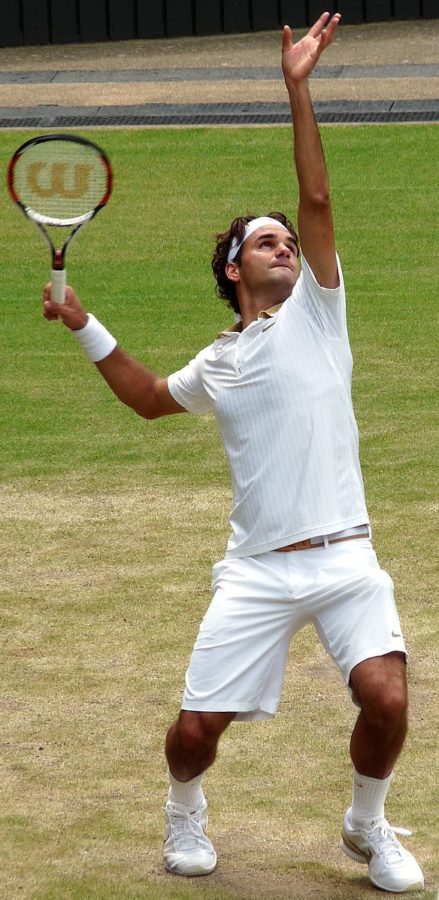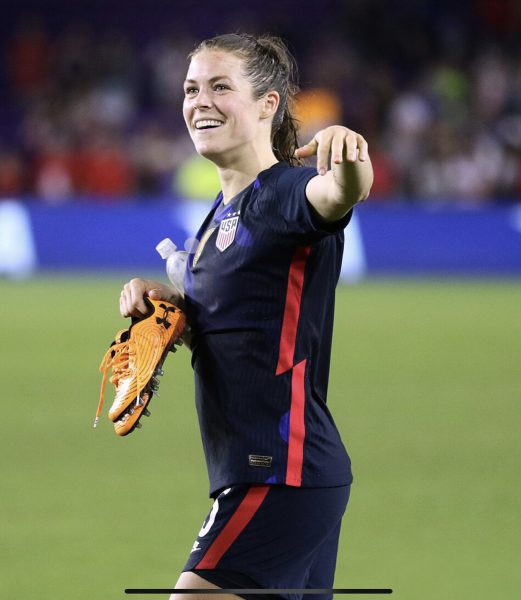You Could Be the Greatest, You Could Be the Best
Evaluating the legends of sports to decide who is the greatest, with a semantic twist.

https://www.floridamemory.com/items/show/61741, Public domain, via Wikimedia Commons
Babe Ruth, one of sports’ most recognizable figures, swings his bat before stepping up to the plate.
The crowds are explosively loud, reflecting the extraordinary play in front of them. Commentators praise the spectacle they have just witnessed as “brilliant.”
And then, there is deafening silence.
Millions watch as sports legends perform, making the most precise motions look like child’s play. The art of their genius is akin to an artist painting a canvas, with each player representing something different — a passion, a country, and a style. Fans, myself included, complain about calls made by “bone-headed” referees, or poor play-calling decisions, seldom appreciating the privilege of watching a master at their craft.
Each athlete, especially the great ones, have ambition to compete at the highest level, to win championships, and to gain personal acclaim. In evaluating each legend, however, complications arise. There are a myriad of moving parts, as comparing people from different eras, different positions, and those without footage makes the process all the more difficult. Nonetheless, devoted sports fanatics devote time to constructing ‘Top Ten’ lists, ranking household names in order of their ‘greatness.’
Even among contemporary athletes, those who have competed during the same era and faced each other dozens of times, evaluating and ranking athletes is often impossible. That said, when considering how players stack up against one another, the words ‘greatest’ and ‘best’ are thrown around interchangeably. However, there is a clear distinction between the greatest players and the best. Let us to take a look at why this is the case.
Football
Perhaps the quarterback debate perfectly encapsulates the difference. The NFL has long been the breeding ground for immense talent and athleticism. However, Tom Brady defied this traditional convention, as despite his “poor build [and] lack [of] great physical stature and strength,” he is recognized as the greatest QB of all time. Brady attended the University of Michigan, and as a senior, split playing time with phenom Drew Henson. Often, Brady would start games, and alternate quarters with Henson, who would quickly lose the Wolverines’ lead. Then, as Patriots Head Coach Bill Belichick reflected, “Tom would come back in, and rescue the situation, and pull out the win for Michigan against great competition.” Brady’s accolades are endless, as his seven Super Bowl Championships stand alone. He is the winningest player ever, and as of his retirement, he holds the NFL records for completions, passing yards, and passing touchdowns. The Comeback Kid brought his spirit from Michigan to the NFL, completing the most Fourth Quarter comebacks in NFL history.

I remember five years ago, bickering with my friends, and trying to convince Jets fans that Brady’s greatness was unmatched. Now, that argument seems truly pointless; Brady has cemented his place as the GOAT (Greatest of All-Time), a result of his unrivaled success in the playoffs (closest competitor has 18 fewer wins), his overall record, and his place at the top of most statistical categories for his position.
However, when those same naysayers attempt to question Brady’s status as the greatest, their arguments have shifted, now focusing on his dominance and talent. For example, former Safety and NFL analyst Ryan Clark has thrown around different qualifications for evaluating who the “greatest” is. Patrick Mahomes, two-time Super Bowl champion and NFL superstar, is among those candidates.
Known for his flashiness and mesmerizing displays of talent, Mahomes is exceptional. His style, utilizing the “air raid” offense to take more shots downfield, juxtaposes Brady’s “dink-and-dunk” passing game, in which short passes and play-action strung together kept defenses off-balance. Still, people often overlook Mahomes’ intangible awareness as a result. Nonetheless, given his lack of longevity (as of right now), it seems inconceivable to proclaim him the greatest.
That said, Clark has asserted that, “based on the eye test and based on the film, [Mahomes is] a better individual quarterback than Tom Brady.”
Though a matter of semantics, I could not help but notice his use of the word “better.” As I interpret this statement, Clark is evaluating the two on a talent level. Mahomes’ athleticism gives his game a dimension Brady never possessed, and his throws, ranging from sidearm to quick pitches, are unique to him. That said, can we not recognize Mahomes’ skill set while respecting Brady’s irreplaceable legacy? Brady is surely the greatest; his name and brand are omnipresent. To my generation, football is characterized by Tom Brady’s number 12, but, does his “greatness” automatically define him as the “best”?
Here are the definitions I compiled as a means of comparison, to differentiate between the greatest and the best. I will be using the below metrics to characterize players.
Greatest – the most successful, prolific, recognizable emblem of their sport with legacy.
Best – the most talented, skilled, and uniquely gifted player, often specific to a fixed time period.
Peter Timling of The Sports Digest described the term “best” as, “[having] a date stamp to it,” declaring it “a snapshot,” while “greatness” applies to “the merits and achievements over a complete career.”
Baseball
Take Shohei Ohtani, the only two-way player (pitcher and hitter) in the MLB, and MVP for the Los Angeles Angels. Ohtani’s gifts are undeniable, and comparisons to Babe Ruth, the consensus pick for greatest of all time, have proven freakishly accurate. Ruth’s legendary status comes from his lasting effect on the game, practically inventing the art of “power hitting.” However, before his Yankee fame, Ruth pitched for the Boston Red Sox, winning the ERA (Earned Run Average) Title (fewest runs allowed per game) in 1916. His prowess both as a hitter and pitcher, two opposite domains of the baseball field, is tremendously rare. In fact, Ohtani, a Japanese-born phenom, is really the first successful two-way player since the Sultan of Swat.
In 2022, Ohtani led the MLB in K/9 (strikeouts per game), placing fourth in voting for the Cy Young Award, given to the sport’s most effective and dominant pitcher. Perhaps equally impressive were his 34 Home Runs, 95 Runs Batted In, and .273 average. Ohtani placed second in MVP voting, falling short of Aaron Judge (as we all do), but few can contest Ohtani’s place as the game’s best performer.
Once again, that difference appears, as Ohtani’s unparalleled success is time-specific and appeals to his sheer ability. By my definition, though, people like Mike Trout, Miguel Cabrera, and recently-retired Albert Pujols have long-lasting success and accolades, and all will have a place at the Hall of Fame in Cooperstown. To be clear, I am not insinuating Ohtani will not reach that bar, but as of 2023, it is hard to envision referring to Ohtani as baseball’s greatest player.
In summary, there is a gravitas to the designation of greatest.
Golf

The argument between Tiger Woods and Jack Nicklaus is another brilliant example of this debate in action. Tiger Woods is synonymous with golf; ask anyone. A motivated, former Stanford student, Woods quickly emerged as the next prodigy. In just his second year on tour, Woods won his first major trophy at the prestigious Masters Tournament (one of four major events held annually). Over his illustrious 20-year career, Woods has amassed a nearly unrivaled fifteen major titles. For a golfer, that resume amounts to four separate all-time great legacies. For reference, Rory McIlroy, a permanent fixture on tour and a future hall-of-famer, has yet to win five titles.

Woods’ competition for the crown is Jack Nicklaus, 18-time major champion and the name synonymous with consistency and longevity. The real debate comes with generations, as Jack is a relative unknown in the up-and-coming community. Despite this, golfers around the world have no issue declaring Jack the undisputed GOAT. Nonetheless, in creating the criteria for “the greatest,” Woods seems to have the edge in notoriety and world acclaim, at least in the modern era.
Tiger is not only the poster child of the PGA, shaping a generation of young golfers, but he has transcended boundaries. In a sport historically dominated by white men, Woods, the first African-American to win the Masters, has thrived as an icon, serving as an integral figure in diversifying the sport. After turning pro as a teenager, Woods’ near immediate success can be attributed to an unparalleled work ethic, making him the face of golf. According to many, he was the most dominant, and perhaps, talented player to play the game, with Chris Chase hailing his prime as the “greatest run of any golfer who’s ever picked up a club.”
Tennis
Perhaps more than any other sport, the debate over who reigns supreme on the tennis court is multidimensional. In particular, the generation of players led by Roger Federer, Rafael Nadal, and Novak Djokovic has proven age is merely a number, with all three players finding tremendous success into their late thirties. All three greats have shined alongside one another, winning 63 of the last 74 major tournaments (since 2004).
After a decisive victory at the 2023 Australian Open, the first major championship of the season, Novak Djokovic finds himself as the co-all-time leader with 22 grand slam titles. His most prolific opponents over the years, Rafael Nadal and Roger Federer, are similarly impressive, as Nadal has also amassed 22 titles, while Federer has 20.
Federer, however, holds a special place in this debate, as the lone member of the ‘Big Three’ to have retired, doing so after two surgeries in 2022.
Continuing from the beginning, the GOAT in tennis is a riveting discussion, one I have only had about seventy-four times with my dad on the couch. Federer, Nadal, and Djokovic are all undeniable in their impact to the game, and determining the greatest between them is no small feat. In my mind, Federer’s global initiatives, being a true ambassador for the sport, perhaps more so than any other player ever, as well as his tremendous accolades and unrivaled peak (unrivaled dominance for a certain short period) make him unique. Talent wise, he is the flashiest, most prolific player, and by that metric, is probably the most gifted. His ambassadorship also gives him a strong case for “greatest.” Enter Novak, the winningest champion, and most acclaimed player of this decade. His style is admittedly a bit boring, but his mobility makes him impossible to overpower.
Tennis legend Martina Navratilova and mega-talent Nick Kyrgios have weighed-in on the GOAT argument in a different light: head-to-head matchups. In the past, Kyrgios has credited the Swiss maestro Federer as being the toughest for him to beat. In fact, in an interview in 2021, Kyrgios gave Roger the crown, declaring him “the greatest of all time.” His praise for Roger continued, calling Federer as, “pure” and “untouchable,” decisively adding that “talent-wise, Nadal and Djokovic aren’t even close to Roger.”
However, time affects each argument, as evidenced by Kyrgios’ most recent contributions to the debate. Federer, who officially retired last year, and played his final match in a major at Wimbledon in 2021, has tapered off in the context of this argument. For 15 years, Federer’s 20 major titles held the all-time record, but that no longer applies. Djokovic has won eight of the last 16 majors, despite not being allowed to participate in two (vaccination requirements), including his best tournament: the Australian Open. Djokovic has surpassed Federer’s major titles mark, outshining him by beating his record for weeks as the number one tennis player in the world. The central difference right now is that Djokovic is still amassing wins and trophies as a prolific superstar while Federer has hung up his racquet.
Back to the head-to-head argument mentioned above, Federer has a losing record to Djokovic, with a 27 – 23 (W – L) advantage to the Serbian. Djokovic leads their major head-to-head 11 – 6, and since 2015, Federer is merely 4 – 10 against his rival. With that context, as well as Novak’s emergence in the record books, it is hard to argue against Djokovic. Clearly, Kyrgios agrees. In his recent interview, the Aussie changed his mind, declaring that “Roger is done for [Kyrgios] in the GOAT talks.” Kyrgios favors Nadal, the third name in the ring. “If [Nadal] wins the French [Open], he is unquestionably the GOAT.”
Nadal’s topspin and competitive drive are unmatched, and his accolades are equally impressive. Nadal’s greatest strength is also his greatest weakness in this argument, as his staggering dominance at certain events accommodates for his other tournaments, in which he has found less success. The French Open, the only major played on clay, is Nadal’s second home. Having participated in 18, Nadal has won a staggering 14 trophies in Paris alone, double anybody else, making his dominance on that surface comical.
That isn’t to say that each player doesn’t have their specific tournament. That is an extra layer to this debate, as Nadal’s clay success can be compared across surfaces. Federer has long been proclaimed the ‘King of Grass,’ with eight wins at Wimbledon in London. Djokovic’s success in Australia is equally remarkable, as he stands alone with 10 titles there.
However, Nadal’s shortcoming is the balance of his major titles. Of the four tournaments, Nadal has struggled, comparatively, in Australia and at Wimbledon, amassing a mere four titles combined. His four U.S. Open trophies place him second all-time in championships there, and the French Open is his gold mine.
Considering Rafa’s success on clay and the French Open (nobody has achieved much at Roland-Garros), Novak’s two titles there are second in the group, but not especially impressive. Neither are his three U.S. Open titles. However, his 10 Australian Open’s are tremendous, and his seven Wimbledon trophies are second all-time, making him one of the great hard-court and grass champions.
Federer has the most balance, with the most Wimbledon trophies ever (8), the most all-time U.S. Open titles (tied with 5), and the second most Australian Open titles (6). His kryptonite, largely a result of Nadal’s clay dominance, is his lone French Open win in 2009. That gives him the fewest titles at a given major tournament of the three.
Nadal’s head-to-head against the Swiss maestro is favorable, as their all-time rivalry has certainly favored him. Their contrasting styles, with Roger playing an aggressive offensive technique and Rafa being a counter-punching lefty with heavy spins, made for riveting and exciting matches. At the end of the day, though, Nadal leads the contest 24 – 16, with Nadal dominating the major head-to-head 10 – 4. That said, Nadal played Federer on clay 16 times, and he, as expected, handled Federer on a staggering 14 occasions. That single-surface performance makes Nadal the most incredible clay player ever. Federer leads the grass matchup 3 – 1, and the hard-court contests by a competitive 11 – 9 margin. Still, Nadal’s control of the head-to-head gives him a strong case. Not to mention, Nadal only trails Novak by two matches in their head-to-head.
Considering the contention around the tennis debate, I will let you decide who should be crowned GOAT, and who might be the best. The case against Djokovic, though, is growing increasingly more difficult, especially with Nadal’s recent injury bouts. Only time will tell, but maybe young phenom Carlos Alcaraz, the current world number one, will place his name amongst these titans.
Conclusion
Sports are ever changing and evolving, true representations of life. Strategies come and go, as do records and legends. What is left behind, though, cultural moments engraved in history, demonstrate its true power. When comparing athletes, it is easy to discredit greatness by virtue of a player not being “Michael Jordan.” Not every player has to be, though. I will conclude with the simple idea that sports is community. Whether we agree on whether Barry Bonds belongs in the hall of fame is irrelevant.
Still, it is fun to compare players, all competing on a grand stage for our entertainment.
That said, when considering how players stack up against one another, the words ‘greatest’ and ‘best’ are thrown around interchangeably. However, there is a clear distinction between the greatest players and the best.
Chase Teichholz is a Copy Chief for ‘The Science Survey.’ He enjoys analyzing historical events and sources, and expressing creativity through writing....











